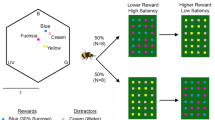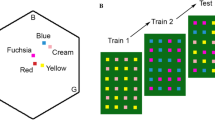Abstract
The timing of learning of colour and shape of the food source, as well as of near-by landmarks, was examined exploiting a behaviour described recently, the “Turn Back and Look” behaviour (TBL): Bees departing from a novel food source after feeding turn around to view it at a short distance (Figs. 2, 3) before departing for the hive. They repeat this behaviour on several successive visits, termed the “TBL phase” (Fig. 5). To examine the function of the TBL, I trained individual bees in 4 different modes. In the first 3 they could view a food source or a landmark of a particular colour or shape during (i) arrival as well as departure, (ii) only arrival, and (iii) only departure; in the final mode (iv) the bees viewed one colour (or shape) on arrival, and another on departure. At the end of the TBL phase, the bees were tested by offering them a choice between the visual stimulus to which they were trained (modes i–iii) and a different (novel) one, or between the stimulus viewed on arrival and that viewed on departure (mode iv). The test results show that learning after feeding (while performing the TBL), i.e. backward conditioning, occurs regardless of whether the colour (Fig. 6, Fig. 10a) or shape (Fig. 7) of the food source, or the colour (Fig. 10b), shape (Fig. 11), and position (Fig. 12) of a near-by landmark is considered. Bees trained in mode (iv) preferred the stimulus learned on arrival over that learned on departure in almost all cases. However, a stimulus viewed exclusively on departure (mode iii) was often learned as well as when it was viewed exclusively on arrival (mode ii) (Figs. 10a, 11, 12), or both on arrival and departure (mode i) (Fig. 6). The finding that the timing of learning can be manipulated suggests that it is not based on hard wired predispositions to learn particular visual cues on arrival, and others on departure.
Similar content being viewed by others
References
Ayres JJB, Haddad C, Albert M (1987) One-trial backward conditioning as assessed by conditioned suppression of licking in rats: Concurrent observations of lick suppression and defensive behaviors. Anim Learn Behav 15:212–217
Bitterman ME, Couvillon PA (1991) Failures to find evidence of adaptive specialization in the learning of honeybees. In: Goodman LJ, Fisher RC (eds) Behaviour and physiology of bees. CAB International, Wallingford, UK, pp 288–305
Cartwright B, Collett TS (1979) How honey-bees know their distance from a near-by visual landmark. J Exp Biol 82:367–372
Cartwright B, Collett TS (1983) Landmark learning in bees: experiments and models. J Comp Physiol 121:521–543
Cheng K, Collett TS, Wehner R (1986) Honeybees learn the colour oflandmarks. J Comp Physiol A 159:69–73
Cheng K, Collett TS, Pickhard A, Wehner R (1987) The use of visual landmarks by honeybees: bees weight landmarks according to their distance from the goal. J Comp Physiol A 161:469–475
Couvillon PA, Bitterman ME (1992) Landmark learning by honeybees. J Insect Behav 5:123–129
Couvillon PA, Leiato TG, Bitterman ME (1991) Learning by honeybees (Apis mellifera) on arrival at and departure from a feeding place. J Comp Psychol 105:177–184
Frisch K von (1965) Tanzsprache und Orientierung der Bienen. Springer, Berlin Heidelberg New York
Gould JL (1982) Ethology: the mechanisms of evolution and behavior. Norton, New York
Gould JL (1988) Timing of landmark learning by honeybees. J Insect Behav 1:373–378
Iersel JJA van, Assem J van den (1964) Aspects of orientation in the diggerwasp Bembix rostrata. Anim Behav Suppl 1:145–162
Lehrer M (1990) How bees use peripheral eye regions to localize a frontally positioned target. J Comp Physiol A 167:173–185
Lehrer M (1991a) Locomotion does more than bring the bee to new places. In: Goodman LJ, Fisher RC (eds) Behaviour and physiology of bees. CAB International, Wallingford, UK, pp 185–202
Lehrer M (1991b) Bees which turn back and look. Naturwissenschaften 78:274–276
Lehrer M, Wehner R, Srinivasan MV (1985) Visual scanning behaviour in honeybees. J Comp Physiol A 157:405–415
Lehrer M, Srinivasan MV, Zhang SW, Horridge GA (1988) Motion cues provide the bee's visual world with a third dimension. Nature (Lond) 332:356–357
Menzel R (1967) Untersuchungen zum Erlernen von Spektralfarben durch die Honigbiene, Apis mellifica. Z Vergl Physiol 56:22–62
Menzel R (1968) Das Gedächtnis der Honigbienen für Spektralfarben. I. Kurzzeitiges und langzeitiges Behalten. Z Vergl Physiol 60:82–102
Menzel R (1990) Learning, memory and “cognition” in honeybees. In: Kesner RP, Olton DS (eds) Neurobiology of comparative cognition. Erlbaum, Hillsdale NJ, pp 237–292
Menzel R, Ventura DF, Hertel H, de Souza JM, Greggers U (1986) Spectral sensitivity of photoreceptors in insect compound eyes: comparison of species and methods. J Comp Physiol A 158:165–177
Opfinger E (1931) Über die Orientierung der Honigbiene an der Futterquelle. Z Vergl Physiol 15:431–487
Pavlov I (1927) The conditioned reflex. Norton, New York
Towne WF, Kirchner WH (1989) Hearing in honeybees: detection of air-particle oscillations. Science 244:686–688
Srinivasan MV, Lehrer M, Zhang SW, Horridge GA (1989) How honeybees measure their distance from objects of unknown sizes. J Comp Physiol A 165:605–613
Vollbehr J (1975) Zur Orientierung junger Honigbienen bei ihrem 1. Orientierungsflug. Zool JB Physiol 79:33–69
Walker MM, Bitterman ME (1989) Attached magnets impair magnetic field discrimination by honeybee. J Exp Biol 141:447–451
Wehner R (1972) Dorsoventral asymmetry in the visual field of the bee, Apis mellifica. J Comp Physiol 77:255–277
Wehner R (1981) Spatial vision in arthropods. In: Autrum H (ed) Comparative physiology and evolution of vision in invertebrates (Handbook of sensory physiology, vol 7/6C). Springer, Berlin Heidelberg New York, pp 287–616
Wehner R, Lehrer M (1988) Visual spatial memory in honeybees: use of landmarks during the approach flight to a food source. In: Elsner N, Barth FG (eds) Sense organs. Proc 16th Göttingen Neurobiology Conference. Thieme, Stuttgart New York, p 229
Zeil J (1993a) Orientation flights of solitary wasps (Cerceris; Sphecidae; Hymenoptera): I. Description of flight. J Comp Physiol A 172:189–205
Zeil J (1993b) Orientation flights of solitary wasps (Cerceris; Sphecidae; Hymenoptera): II. Similarity between orientation and return flights and the use of motion parallax. J Comp Physiol A 172:207–222
Zhang SW, Srinivasan MV, Horridge GA (1992) Pattern recognition in honeybees: local and global analysis. Proc R Soc Lond B 248:55–61
Author information
Authors and Affiliations
Rights and permissions
About this article
Cite this article
Lehrer, M. Why do bees turn back and look?. J Comp Physiol A 172, 549–563 (1993). https://doi.org/10.1007/BF00213678
Accepted:
Issue Date:
DOI: https://doi.org/10.1007/BF00213678




